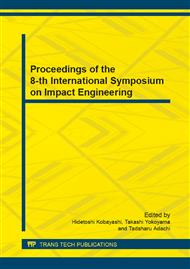p.310
p.316
p.325
p.332
p.338
p.344
p.353
p.359
p.365
Ejecta Size Distribution Resulting from Hypervelocity Impacts between Aluminum Alloys
Abstract:
We investigated the effects of impact velocity on ejecta size when aluminum alloy 2017-T4 spheres with a diameter of 3.2 mm impacted aluminum alloy 6061-T6 targets with a thickness of 30 mm at velocities of 2 to 7 km/s. We used a two-stage light-gas gun at the Institute of Space and Astronautical Science (ISAS)/Japan Aerospace Exploration Agency (JAXA). To examine the scattering angles of the ejecta, the following was placed 50 mm in front of the target: a witness plate (150 mm × 150 mm, 2 mm in thickness) made of copper with a hole of 30 mm. The ejection behaviors of fragments were observed using a high-speed video camera. The size distributions of the ejecta were examined in detail. The cumulative number of ejecta was proportional to the square of the impact velocity; in other words, to the impact energy of the projectiles. An experimental formula was created by curve fitting of the cumulative number distribution of the projected areas to a bilinear exponential distribution model when the aluminum alloy spheres struck the aluminum alloy targets.
Info:
Periodical:
Pages:
338-343
Citation:
Online since:
June 2014
Authors:
Price:
Сopyright:
© 2014 Trans Tech Publications Ltd. All Rights Reserved
Share:
Citation:


